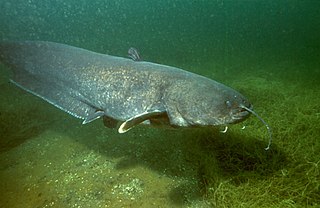Related Research Articles

Noodling is fishing for catfish using one's bare hands or feet, and is practiced primarily in the southern United States. The noodler places their hand or foot inside a discovered catfish hole in order to catch the fish. Other names for the same activity are used in different regions, primarily in the South and Midwest, and include hogging, dogging, grappling, grabbling, and tickling.

The iridescent shark,iridescent shark catfish is a species of shark catfish native to the rivers of Southeast Asia. Despite its name, it is not a shark. It is found in the Mekong basin as well as the Chao Phraya River, and is heavily cultivated for food there.

An aquarist is a person who manages aquariums, either professionally or as a hobby. They typically care for aquatic animals, including fish and marine invertebrates. Some may care for aquatic mammals. Aquarists often work at public aquariums. They may also work at nature reserves, zoos, and amusement parks. Some aquarists conduct field research outdoors. In business, aquarists may work at pet stores, as commercial fish breeders, or as manufacturers. Some aquarists are hobbyists, also known as "home aquarists," who may vary in skills and experience.

Pole sitting is the practice of sitting on top of a pole for extended lengths of time, generally used as a test of endurance. A small platform is typically placed at the top of the pole for the sitter. Led by the stunt actor and former sailor Alvin "Shipwreck" Kelly, flagpole sitting was a fad in the mid-to-late 1920s, but mostly died out after the start of the Great Depression.

Fishkeeping is a popular hobby, practiced by aquarists, concerned with keeping fish in a home aquarium or garden pond. There is also a piscicultural fishkeeping industry, serving as a branch of agriculture.

The wels catfish, also called sheatfish or just wels, is a large species of catfish native to wide areas of central, southern, and eastern Europe, in the basins of the Baltic, Black and Caspian Seas. It has been introduced to Western Europe as a prized sport fish and is now found from the United Kingdom east to Kazakhstan and China and south to Greece and Turkey.

Feeder fish is the common name for certain types of small, inexpensive fish commonly fed as live food to other captive animals such as predatory fishes or carnivorous aquarium fish, turtles, crocodilians and other piscivores that naturally hunt in fresh, brackish or salt water ecosystems.

Pterygoplichthys gibbiceps is a species of armored catfish native to Brazil, Ecuador, Peru and Venezuela where it is found in the Orinoco and Amazon basins.

Mac King is an American magician who has performed on television specials, often as a co-host. He has his own family-friendly show, "The Mac King Comedy Magic Show", at the Excalibur Hotel and Casino in the Thunderland Showroom, in Las Vegas, Nevada. King's show is currently the longest running one-man show in the history of Las Vegas.
Ryan Stock is a Canadian-based TV stunt man from Beaumont, Alberta who has a show on the Discovery Channel called "Guinea Pig". Stock and his fiancée Amber Lynn Walker travel around Canada and the United States and perform stunts involving electrical shocks, automobile crashes and intentional poisoning. The Guinea pig show is no longer in production but may still air in some countries.

A freshwater aquarium is a receptacle that holds one or more freshwater aquatic organisms for decorative, pet-keeping, or research purposes. Modern aquariums are most often made from transparent glass or acrylic glass. Typical inhabitants include fish, plants, amphibians, and invertebrates, such as snails and crustaceans.

Asterophysus batrachus, the gulper catfish or ogre catfish, is a species of catfish of the family Auchenipteridae. It is native to the Rio Negro and Orinoco basins in Brazil, Colombia and Venezuela, where mostly found in slow-moving waters with many submerged structures. It is currently the only recognized species of the genus Asterophysus, but a specimen that possibly represents an undescribed species has been collected in Marajó.

The goldfish is a freshwater fish in the family Cyprinidae of order Cypriniformes. It is commonly kept as a pet in indoor aquariums, and is one of the most popular aquarium fish. Goldfish released into the wild have become an invasive pest in parts of North America.

Hadji Ali was a vaudeville performance artist, thought to be of Egyptian descent, who was famous for acts of controlled regurgitation. His best-known feats included water spouting, smoke swallowing, and nut and handkerchief swallowing followed by disgorgement in an order chosen by the audience. Ali's most famous stunt, and the highlight of his act, was drinking copious amounts of water followed by kerosene, and then acting by turns as a human flamethrower and fire extinguisher as he expelled the two liquids onto a theatrical prop. While these stunts were performed, a panel of audience members was invited to watch the show up close to verify that no trickery was employed.

Hydrocynus vittatus, the African tigerfish, tiervis or ngwesh is a predatory freshwater fish distributed throughout much of Africa. This fish is generally a piscivore but it has been observed leaping out of the water and catching barn swallows in flight.

Eating live animals is the practice of humans eating animals that are still alive. It is a traditional practice in many East Asian food cultures. Animals may also be eaten alive for shock value. Eating live animals, or parts of live animals, may be unlawful in certain jurisdictions under animal cruelty laws. Religious prohibitions on the eating of live animals by humans are also present in various world religions.

Donald's Penguin is a Donald Duck animated Technicolor short film by Walt Disney Productions and directed by Jack King, which was originally released on May 16, 1939, by RKO Radio Pictures. The story was written by Carl Barks.

The Harvard–Yale soccer rivalry is a rivalry between Harvard University and Yale University. The men's series has been played regularly since 1907, while the women's teams have played since 1977. For over fifty years, the annual Harvard–Yale soccer game was played as a "curtain raiser" to the schools' gridiron football game, known simply as The Game. In addition to its varsity soccer teams which compete in the Ivy League, the two schools' intramural soccer champions have regularly featured in the annual Harkness Cup games, named after Edward Harkness, a benefactor of both universities.
Nick Tobler is an American TikToker best known for raising eels and other fish in his house's cistern.
References
- 1 2 3 4 5 Meyer, Amelia (January 12, 2011). "1939: The year of goldfish gulping". National Museum of American History Behring Center. Smithsonian National Museum of American History. Retrieved March 13, 2019.
- 1 2 3 4 Clark, Laura. "The Great Goldfish Swallowing Craze of 1939 Never Really Ended". Smithsonian Magazine. Retrieved 2018-04-30.
- 1 2 "College Bros in the 1930s Were the Champs of Goldfish Swallowing". Ripley's Believe It or Not! . 2018-02-13. Retrieved 2018-04-30.
- ↑ "Albert E. Hayes, Jr. '42, Crowned New Champion Of Intercollegiate Goldfish Swallowers Yesterday" (PDF). The Tech. Vol. 59, no. 16. Cambridge, Massachusetts: Massachusetts Institute of Technology. 1939-03-31. Retrieved 2021-05-15.
- 1 2 Weiss, Haley (2019-01-26). "This Is What Happens When You Drunkenly Swallow a Live Catfish". The Atlantic. Retrieved 2021-05-15.
- 1 2 Burgheim, Richard A. (6 May 1952). "Goldfish Swallowing: College Fad Started Here, Spread Over World". The Harvard Crimson . Retrieved 27 May 2018.
- 1 2 Andrews, Stefan (2019-02-05). "The Hottest Challenge on 1930s College Campuses - Swallowing Goldfish". The Vintage News. Retrieved 2021-05-15.
- ↑ Steadman, Ian (11 February 2014). "How long can a goldfish survive if you swallow it?". New Statesman. Retrieved 2018-05-21.
- ↑ "Settlement reached in UVa swim team hazing lawsuit". San Diego Union-Tribune. 2016-03-29. Retrieved 2021-05-15.
- ↑ Withnall, Adam (2014-07-24). "Neknomination goldfish swallowing 'prank' sees 20-year-old Jack". The Independent . Retrieved 2021-05-15.
- ↑ Hermann, Adam (2019-01-10). "N.J. man who allegedly ate pet fish arrested after more than two years on run". PhillyVoice. Retrieved 2021-05-15.
- ↑ Seldon, Aja (2019-01-10). "Man eats ex-girlfriend's pet fish, sends photo with caption 'found your fish'". KRON4. Retrieved 2021-05-15.
- ↑ "Bizarre: Man accused of eating LSU student's pet fish, arrested two years later". WBRZ. 2019-01-08. Retrieved 2021-05-15.
- ↑ "Not Funny Sleights --- Live Magic Fades". Chicago Tribune. Chicago, Illinois. 2012-01-19. pp. 5–6. Retrieved 2021-05-15– via Newspapers.com.
- ↑ Lasher, Micah (1996). The Magic of Micah Lasher: More Than Fifty Tricks That Will Amaze and Delight Everyone --- Including You. Akemi Yoshida. New York, NY: Simon & Schuster. p. 173. ISBN 0-684-81390-4.
{{cite book}}:|work=ignored (help) - ↑ "Pretty Soon It May be Safe for a Goldfish to Go to College". Nashua Telegraph. Nashua, N.H. 1939-04-14. p. 15. Retrieved 2021-05-15.
- ↑ "A Drunk Man Swallowed a Live, Venomous, Spiny Catfish. Here's What Happened". Live Science . 25 January 2019.